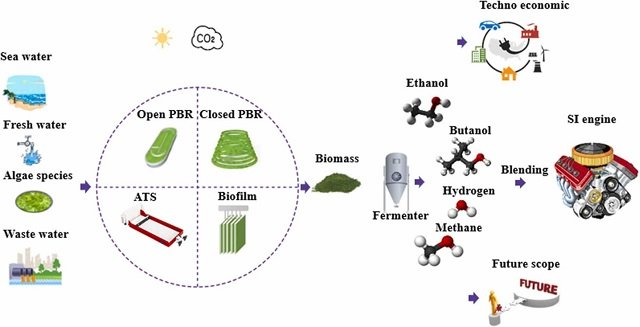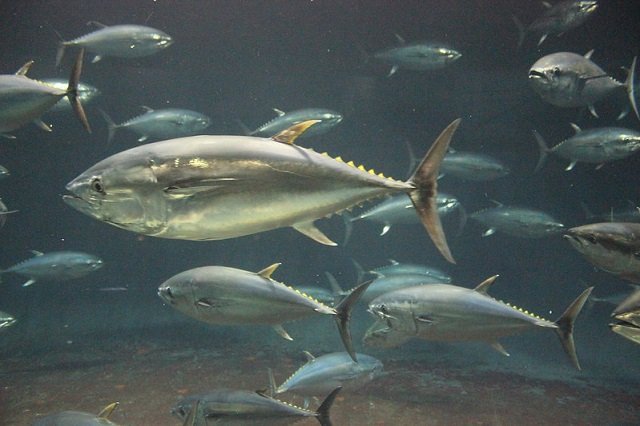
Microalgae are not only fundamental to Earth’s ecosystems but also hold immense biotechnological potential. From carbon capture to the production of high-value bioproducts and biofuels, microalgae are paving the way for sustainable industrial applications.
However, despite their vast biodiversity, the microalgae industry remains constrained by its reliance on a limited number of species. This bottleneck underscores the urgent need for innovative bioprospecting strategies to unlock the full potential of these extraordinary organisms.
New research has highlighted the capability of microalgae as a solution to combat climate change, but researchers warn that “intelligent microalgae bioprospecting” is necessary to unleash their full potential.
In this context, researchers from the University of Technology Sydney have published a scientific review emphasizing the importance of microalgae bioprospecting and critically exploring commonly employed methodologies.
The role of microalgae in a green circular economy
- 1 The role of microalgae in a green circular economy
- 2 The challenge of microalgae bioprospecting
-
3
Advances in microalgae bioprospecting: A transdisciplinary approach
- 3.1 Bio-rational sampling
- 3.2 Multivariate approaches
- 3.3 Automation and high-throughput cultivation
- 3.4 Flow Cytometry (FC) and Fluorescence-Activated Cell Sorting (FACS)
- 3.5 Countercurrent centrifugation
- 3.6 Advanced molecular identification
- 3.7 Culture-independent bioprospecting
- 3.8 Fluorescent probing (FP)
- 3.9 Biosensors
- 3.10 Reversible electroporation
- 4 The future of microalgae bioprospecting
- 5 Conclusion
- 6 Entradas relacionadas:
Amid rising CO2 emissions and climate change, the development of green circular economies has become a global priority. Microalgae, with their exceptional photosynthetic efficiency and ability to fix atmospheric carbon dioxide, are emerging as key players in this transition. These microorganisms can convert CO2 into biomass, which can then be processed to produce biofuels, bioplastics, pharmaceuticals, and other high-value products. Unlike traditional crops, microalgae do not compete for arable land, making them an environmentally friendly alternative for sustainable production.
“Microalgae have remarkable properties that make them an ideal tool for tackling climate change,” said lead author and PhD candidate Joan Labara Tirado from the University of Technology Sydney (UTS).
Microalgae encompass a diverse group of taxa found in virtually all of Earth’s habitats. This biodiversity translates into a wide range of physiological functions and biochemical compositions, offering a treasure trove of untapped resources for industrial applications. However, despite this potential, the microalgae industry currently exploits only a handful of species, limiting its ability to harness the full spectrum of available biological properties.
“So far, we’re only scratching the surface,” Labara Tirado stated. Only a small fraction of the thousands of microalgae species have been studied, leaving many opportunities for climate innovation unexplored.
Stay Always Informed
Join our communities to instantly receive the most important news, reports, and analysis from the aquaculture industry.
“There are thousands of undiscovered microalgae species, each with potentially unique properties that could transform sectors such as bioenergy, medicine, or bioplastics.”
The challenge of microalgae bioprospecting
Bioprospecting—the systematic search for new biological resources with commercial or biotechnological potential—plays a crucial role in identifying and developing new microalgae strains for industrial and environmental applications.
This process involves discovering new species, analyzing their biochemical properties, and evaluating their potential to contribute to climate solutions. However, current bioprospecting efforts are hindered by inefficient workflows, non-selective sampling methods, and outdated characterization techniques. These limitations result in low-yield, time-consuming processes that fail to meet the growing demand for sustainable solutions.
Traditional bioprospecting heavily relies on monoculture cultivation and non-standardized methodologies, often overlooking the vast diversity of microalgae species. This limited approach restricts the discovery of new strains with unique properties that could revolutionize industries ranging from renewable energy to healthcare.
Advances in microalgae bioprospecting: A transdisciplinary approach
The discovery of new microalgae species with enhanced growth rates, higher CO2 absorption efficiency, or lower resource demands could drastically reduce costs.
“By identifying and harnessing species that thrive in diverse environmental conditions or require minimal inputs, researchers could pave the way for more economically viable carbon sequestration solutions,” said Labara Tirado.
“But to get there, we need greater investment in intelligent microalgae bioprospecting, leveraging advanced technology and research methods to find and develop new strains for industrial and environmental applications.”
To enhance the efficiency of microalgae bioprospecting, Labara’s study suggests the following strategies:
Bio-rational sampling
Instead of indiscriminately sampling, a critical assessment of sampling locations should be conducted, considering ecological pressures that may generate desired phenotypic traits in microalgae. This approach, known as bio-rational collection and selection, increases the likelihood of isolating the desired microalgae.
Multivariate approaches
Combining bio-rational sampling with rigorous laboratory cultivation conditions that mimic natural pressures reduces the number of microalgae strains to be characterized, lowering both economic and time costs.
Automation and high-throughput cultivation
Implementing automated and high-throughput cultivation methodologies, such as multi-well plates and microfluidic platforms, offers superior efficiency in terms of time and the number of nutrient profiles tested.
Flow Cytometry (FC) and Fluorescence-Activated Cell Sorting (FACS)
Using FC to rapidly analyze environmental samples by interrogating individual cells. FACS enables the isolation of desired populations based on specific parameters, revolutionizing the isolation of microalgae in monoalgal and axenic cultures.
Countercurrent centrifugation
Exploring the potential of countercurrent centrifugation for size-based separation of different microalgae taxa and their common contaminants, facilitating axenic monoalgal isolation.
Advanced molecular identification
Implementing Artificial Intelligence (AI) and molecular identification technologies to reduce human error and bias in microalgae identification. This includes the development of deep-learning-based image recognition software and high-throughput metabarcoding methodologies.
Culture-independent bioprospecting
Using metagenomic approaches such as Whole Genome Shotgun sequencing for culture-independent bioprospecting. Advances in Next-Generation Sequencing (NGS) and global sequencing projects allow in silico searches for genes encoding biomolecules.
Fluorescent probing (FP)
Employing autofluorescent molecules or fluorophores specific to target molecules to identify and quantify key metabolites. Integrating FP with FACS or microplate workflows provides superior efficiency compared to traditional lipid quantifications.
Biosensors
Developing novel platforms specific to metabolites, such as aptamers—small DNA, RNA, or peptide chains that bind specifically to biomolecular targets. These aptamers can be modified and linked to fluorophores or Quantum Dots to enhance detection.
Reversible electroporation
Using reversible electroporation—the transient electro-generation of temporary membrane pores—as a reliable method for intracellular delivery in various microalgae taxa. Size-based fractionation of a non-monoalgal sample and its distribution through different electroporation parameter gradients could be essential for achieving efficient intracellular delivery across taxa.
The future of microalgae bioprospecting
The potential of microalgae to drive sustainable innovation is immense, but unlocking it requires a paradigm shift in how bioprospecting is approached. According to the study’s authors, by adopting intelligent and high-throughput methodologies, researchers can fully explore microalgae biodiversity, uncovering new species with unique properties that could transform industries and contribute to a greener future.
As the demand for sustainable solutions continues to grow, microalgae bioprospecting will play a crucial role in developing the necessary technologies to address global challenges such as climate change, resource scarcity, and environmental degradation. By fostering interdisciplinary collaboration and leveraging the latest scientific advancements, we can harness the power of microalgae to build a more sustainable and resilient world.
Conclusion
Microalgae represent a vast untapped resource with the potential to revolutionize industries and contribute to a green circular economy. However, fully realizing this potential requires overcoming the limitations of current bioprospecting methods.
The study argues that to fully harness the potential of microalgae across diverse industries, it is crucial to adopt a more strategic, efficient, and technology-driven approach to bioprospecting. This will enable the faster and more precise identification of microalgae strains with desirable characteristics, driving the expansion and economic success of the microalgae industry.
Contact
Joan Labara Tirado
Faculty of Science, Climate Change Cluster (C3), Algal Biotechnology & Biosystems, University of Technology Sydney
Sydney, NSW, 2007, Australia
Email: Joan.labaratirado@student.uts.edu.au
Reference (open access)
Labara Tirado, J., Herdean, A. & Ralph, P.J. The need for smart microalgal bioprospecting. Nat. Prod. Bioprospect. 15, 7 (2025). https://doi.org/10.1007/s13659-024-00487-3
Editor at the digital magazine AquaHoy. He holds a degree in Aquaculture Biology from the National University of Santa (UNS) and a Master’s degree in Science and Innovation Management from the Polytechnic University of Valencia, with postgraduate diplomas in Business Innovation and Innovation Management. He possesses extensive experience in the aquaculture and fisheries sector, having led the Fisheries Innovation Unit of the National Program for Innovation in Fisheries and Aquaculture (PNIPA). He has served as a senior consultant in technology watch, an innovation project formulator and advisor, and a lecturer at UNS. He is a member of the Peruvian College of Biologists and was recognized by the World Aquaculture Society (WAS) in 2016 for his contribution to aquaculture.




